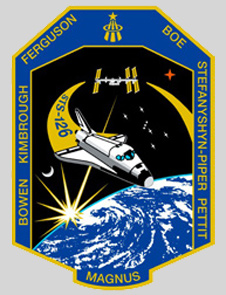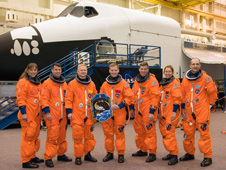In the STS-126 mission, residential facilities and water production systems will be brought to the space station, and four spacewalks will be carried out to repair the bearing of one of the station's solar collectors in preparation to improve the power generation capacity in preparation for doubling the crew members to six

For years, STS-126 was planned as a mission that would give the International Space Station the ability to support a crew twice its current size. However, since the last tests done on the bearings of the Alpha solar collector, the renovation of the collector has also become a goal for the astronauts to ensure that the station can generate the power required for the other crew members. The shuttle Endeavor is expected to be launched this Friday, November 14.
The crew members are expected to have four compressed spacewalks outside the station, but also a lot of work for those who will remain inside the station. According to Ginger Crick, the space station operations manager for this mission. The power generated by the two solar collectors being prepared will be used next year when the station's crew will increase to six people instead of the current three. The Endeavor crew members' main goal is to prepare the station for this expansion, and so they are bringing with them on the shuttle's cargo deck a multipurpose logistics component loaded with 15 tons of equipment. "This is the largest logistics package brought up to the station to date," said STS-126 mission commander Chris Ferguson. "We put up a bedroom for three, one bathroom and turn all of this into a room for five people, two toilets and a physical fitness facility.
The Alpha adjustable solar collector bearing is a wheel with a diameter of 4.5 meters that is on the station's main axis and allows the electricity-producing solar collectors to rotate so that they always get as much sunlight as possible. Flight controllers on the ground noticed a year ago that it took more force than usual to rotate the alpha solar collector on the right side of the station and that the bearing was shaking more than it should.
During several spacewalks conducted to test the bearing, the engineers from over a hundred possible reasons narrowed it down to just one: insufficient frictional capacity. Without enough friction, the joints between the two parts of the bearing, which allow one side to rotate while the other side remains fixed, press too hard against one side of the bearing. This adds pressure that damaged the steel of the "wheel", with the metal chips that are created during the process causing additional damage. Therefore, spacewalkers Heidimarie Stephenshin-Piefer, Steve Bowen and Shane Kibro will spend most of their time on the four planned spacewalks during the 15-year mission to repair the bearing. They will also begin cleaning the metal shavings from the surface, apply it and replace the damaged components, which is more complicated than planned for this task in advance, especially due to the space conditions.

In fact, the astronauts will perform the same job several times - removing the cover, removing the shaft, cleaning, lubricating, replacing the shaft and its parts and re-covering the system with a heat shield. This mission will therefore be divided over three spacewalks. On the fourth spacewalk they will fill in the friction material.
The second bearing does not suffer from problems and damage, but to be safe, the astronauts also smoothed its surface to prevent problems from developing in the future. The crew members who will remain inside the station - the pilot Eric Beau, the astronaut Donald Pettit and the substitute flight engineer who will remain on the space station in place of Greg Chaimtoff, will install a new living quarters, toilets, a refrigerator kitchen and physical fitness facilities, as well as scientific experiments.
For this purpose, the astronauts will make use of the storage volumes uploaded to the station in the previous missions - Node 2, Columbus and Kibo
The equipment that will be loaded on Endeavour, will allow the astronauts to be less dependent on the shuttles. A climate control system and life support systems will give the station the ability to recycle the urine and gases that come out of the astronauts' exhalations into clean water that can be used for drinking or for cooling the station's systems. This will be especially important after the shutdown of the ferry fleet in 2010, when the water that is currently brought up through the crossings will stop arriving.
The water that will be produced in the near future using the facility will not be used for drinking but will undergo a series of tests and many samples will be sent to Earth for analysis. Therefore, the system will be activated before the astronauts' gonorrhea.
If all goes well, they will also have time to celebrate the tenth birthday of the space station, starting on November 10, 10 years since the launch of the Zarya component into space, and the start of assembly work.
